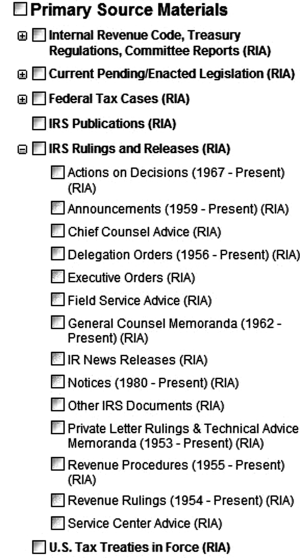Tax Research Databases
Tax research databases include both primary and secondary sources. A primary source generally comes from the Internal Revenue Code, Treasury Regulations, Revenue Rulings, Revenue Procedures, and case decisions from the various courts. One tax research database's classification of primary sources is shown in Exhibit 5-1. Others will classify primary sources as those from the government having precedential authority.
Exhibit 5-1 Primary Source Materials on Checkpoint
Source: Checkpoint® screenshot, published online at http://checkpoint.riag.com. © 2012. Thomson Reuters/RIA. Reprinted with permission. All rights reserved. This information or any portion thereof may not be copied or disseminated in any form or by any means or stored in an electronic database or retrieval system without the express consent of Thomson/RIA.

Secondary sources are often useful for acquiring a basic understanding of the relevant topics. Such secondary tax sources provide expert tax analysis and often cite to primary source material. One popular secondary source is the Masters of Tax Guide, which summarizes the tax law in a single volume. Another excellent source is the Bureau of National Affairs’ (BNA) Tax Management Portfolios. The more than 450 Portfolios are in three categories: U.S. Income Tax; Estates, Gifts, and Trusts; and Foreign Income.
Various tax journals, such as Tax Notes ...
Get Accounting and Auditing Research and Databases: Practitioner's Desk Reference now with the O’Reilly learning platform.
O’Reilly members experience books, live events, courses curated by job role, and more from O’Reilly and nearly 200 top publishers.

